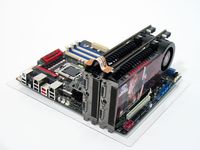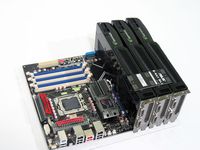Core i7: 4-Way CrossFire, 3-way SLI, Paradise?
Caveats, Realism, And Driver Hell
Intel’s X58 chipset gives us the opportunity to make gaming comparisons never before possible given its support for CrossFireX and SLI. We were understandably very excited about what this meant for the latest multi-card rendering technologies. Of course, in an ideal world, this would have also meant a smooth, relaxing testing scenario as we swapped graphics cards in and out, uninstalling and reinstalling drivers as we went. Unfortunately, that’s a gross oversimplification of how things go in a lab.
The first thing to bear in mind when it comes to dealing with a pile of the highest-end hardware is that it all runs surprisingly hot—so much so that it becomes necessary to let the various configurations sit for a few minutes before swapping hardware to avoid burns. In any of these platforms, a single Radeon HD 4870 or GeForce GTX 280 easily keeps up with the thermal situation by spinning onboard blowers up to cope with demanding 3D workloads. A single Radeon HD 4870 X2—representing our 2 x Radeon HD 4870 scores—is similarly capable of scaling fan speed on its own. Two GeForce GTX 280s even behave well enough, given the two slots between cards encouraged by Nvidia’s rigid SLI connector. But when you shift over to 3-way SLI, with three cards smashed up against each other, or quad-CrossFireX using a pair of Radeon HD 4870 X2s side-by-side, temperatures quickly get out of hand and easily cause stability issues. As a general rule, we took matters into our own hands while using four-way CrossFireX and 3-way SLI by installing RivaTuner or using the Catalyst 8.10 drivers to manually adjust fan speed. The side effect is an unfortunate amount of noise. Such is the price you pay to play.
Drowning In Drivers
Then there’s the issue of drivers and recently released games. In talking to a handful of folks over at AMD, had we had access to Core i7 and X58 back in July, we could have dropped Radeon HD 4800-series cards into the platform and run CrossFire mode. The platform support was already there, ready to go. And yet, in the past two weeks, we’ve received three official driver updates to improve performance. AMD says it isn’t trying to frantically patch in support for the platform, but we’ve certainly been frantically testing and re-testing in order to keep up with its steady stream of “faster” drivers optimized for just a handful of games that weren’t performing as well as the company had hoped.
The situation with Nvidia has been much smoother. But even there we have a scheduled roll-out of software that isn’t quite ready. First, the company made its GeForce 180.43 beta driver set available, adding support for SLI on X58. Currently, those drivers only include partial support for what will eventually be the final GeForce 180 release, set to include multi-monitor SLI and the ability to designate a GPU for PhysX processing. As of the Core i7 embargo, those features are still not available
Keep each company’s respective software position in mind as your peruse the benchmarks. There are a number of results where something is clearly amiss, and we’ll happily identify some of the stranger scores.
Intel Tempers Expectations
Back at IDF, Intel sat us down in a small-group session to show off some preliminary Core i7 benchmark scores and share the details of what it would ship come launch time. We knew the top-end part would run at 3.2 GHz. We knew Intel’s own DX58SO motherboard would clumsily present three channels of memory across four slots (and we know that the enthusiast-minded reps within the company aren’t necessarily pleased about the board’s setup). And by the end of Intel’s presentation, we already had a good idea of where its architecture would excel and where it would fall short as a result of design compromises.
You see, Intel’s Core 2 micro-architecture employed a large, shared L2 cache—the top-end Penryn-based Wofldales consisted of two cores dynamically accessing 6 MB of very fast memory. Core i7 gives each of four cores its own 256 KB L2 cache and a much larger (and slower) shared 8MB L3. As a result of the new cache architecture (and re-introduction of Hyper-Threading), Core i7 desktop chips chew through encoding apps much faster than ever before. But they don’t present the sort of improvements that would accelerate gaming. Intel let us in on this bit of information back at IDF, tempering our expectations of what to expect by claiming whatever speed-ups we did see would be a product of the processor’s Turbo mode pushing quicker clock speeds.
Get Tom's Hardware's best news and in-depth reviews, straight to your inbox.
Current page: Caveats, Realism, And Driver Hell
Prev Page X58 And SLI Get Busy Next Page Hardware Enthusiast’s Paradise-
DFGum Yep, i hafta say being able to switch brands of graphics cards on a whim and selling off the old is great. Knowing im going to be getting the preformance these cards are capable of (better price to preformance ratio) is nice also.Reply -
cangelini randomizerSLI scales so nicely on X58.Reply
Hey you even got a "First" in there Randomizer! -
randomizer cangeliniHey you even got a "First" in there Randomizer!And modest old me didn't even mention it. :lol:Reply -
enewmen Still waiting for the 4870 X2s to be used in these bechmarks. I thought THG got a couple for the $4500 exteme system. But still happy to see articles like this so early!Reply -
cangelini enewmenStill waiting for the 4870 X2s to be used in these bechmarks. I thought THG got a couple for the $4500 exteme system. But still happy to see articles like this so early!Reply
Go check out the benchmark pages man! Every one with 1, 2, 4 4870s. The 2x and 4x configs are achieved with X2s, too.
Oh, and latest drivers all around, too. Crazy, I know! =) -
enewmen cangeliniI found it, just read the article too quickly. - My bad.Reply
"A single Radeon HD 4870 X2—representing our 2 x Radeon HD 4870 scores—is similarly capable of scaling fan speed on its own. "
Hope to see driver updates like you said. -
spyde Hi there, my question regarding these benchmarks with the HD card is, "was a 2G card use or a 1G". I am about to buy a new system and was looking to buy 2 x HD4870X2 2G cards, but with these results its looking a bit ify. I hope you can answer my question.Reply
Cheers. -
Proximon That's a nice article. I especially like the way the graphs are done. everything is scaled right, and you get an accurate representation.Reply


